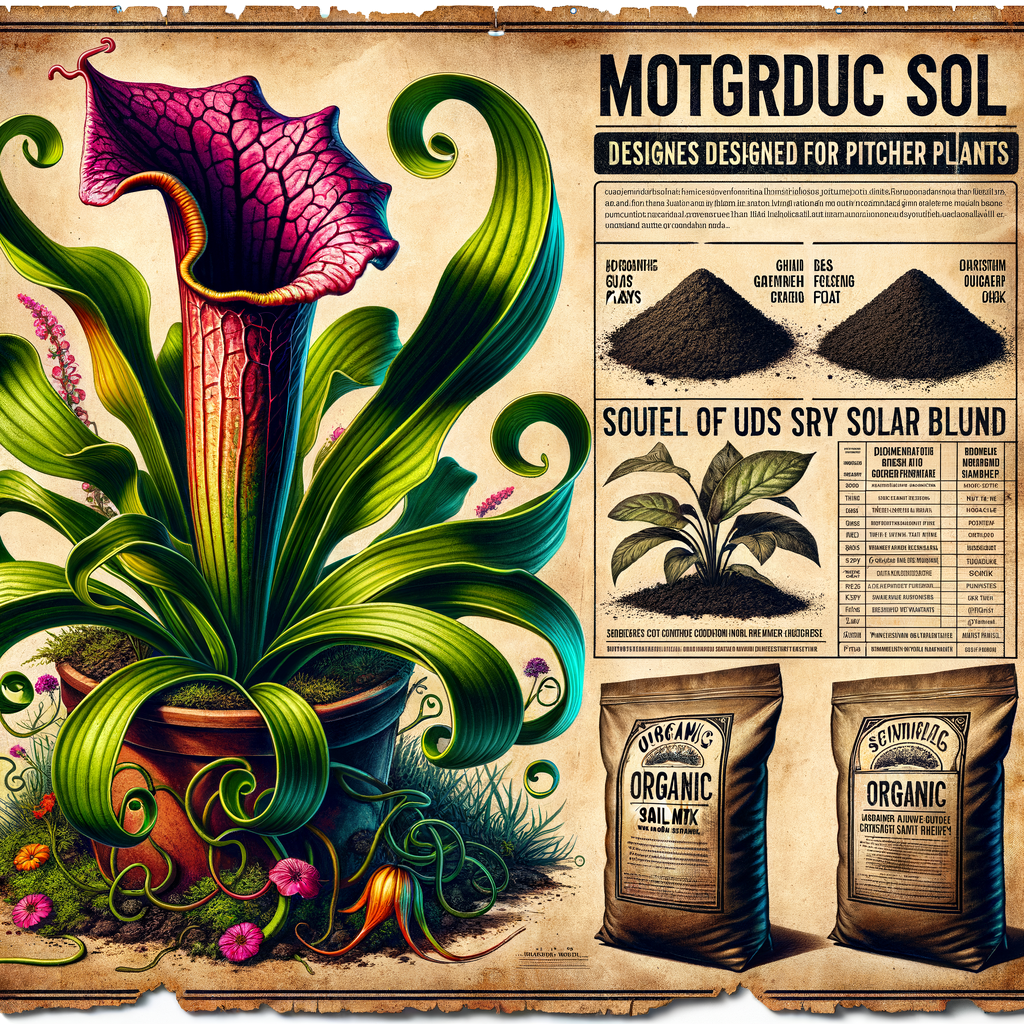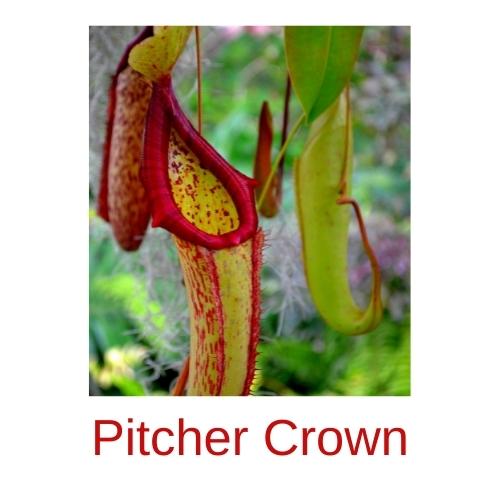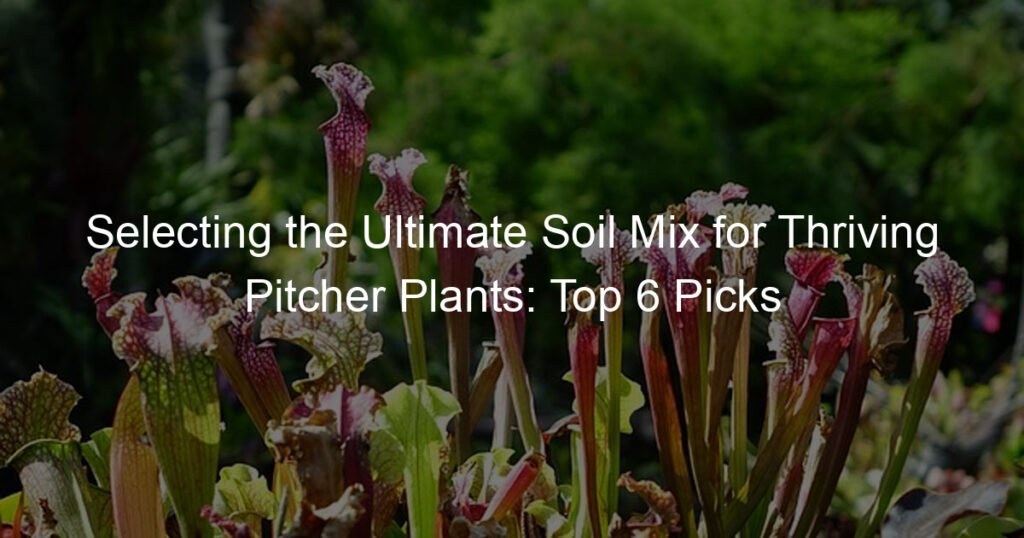
Introduction to Pitcher Plant Care
Welcome to our comprehensive guide on the care of the fascinating Pitcher Plants. These unique plants, known for their carnivorous nature, have specific needs that differ from most common houseplants. Understanding these needs is the first step towards successful cultivation.
- Understanding the unique needs of Pitcher Plants
- Importance of the right soil mix for healthy growth of Pitcher Plants
Pitcher Plants are a group of carnivorous plants that have evolved to thrive in nutrient-poor environments. They have developed a unique way of supplementing their nutrient intake by trapping and digesting insects. This adaptation means they have specific care requirements that need to be met for them to thrive.
For instance, they require a high humidity environment, plenty of light, and a specific soil mix that mimics their natural habitat. They also need a dormant period during winter to rest and rejuvenate.
The soil mix for Pitcher Plants is one of the most critical aspects of their care. These plants naturally grow in boggy areas with poor, acidic soil. Therefore, the soil mix you use for your Pitcher Plant should mimic these conditions.
A good soil mix for Pitcher Plants usually consists of a blend of sphagnum moss and sand or perlite. This mix provides the necessary drainage and acidity while also being low in nutrients, which is essential for the plant’s health.
In the following sections, we will delve deeper into the perfect soil blend for Pitcher Plants, our top picks for Pitcher Plant soil mix, and how to create your own mix. We will also explore the ideal growing conditions for these plants. By the end of this guide, you will be well-equipped to ensure your Pitcher Plants thrive with the right soil mix.
Understanding the Perfect Soil Blend for Pitcher Plants
When it comes to growing pitcher plants, the soil you choose plays a significant role. It’s not just about picking any soil; it’s about understanding the perfect blend that these unique plants need to thrive. Let’s delve into the key components of the best soil for pitcher plants.
Key Components of the Best Soil for Pitcher Plants
There are two main components that make up the best soil for pitcher plants. These are organic soil and proper drainage. Let’s take a closer look at each of these components.
- Importance of Organic Soil for Pitcher Plants
- Role of Drainage in Pitcher Plant Soil Preparation
Pitcher plants, like all plants, need nutrients to grow. However, they have adapted to live in nutrient-poor environments, which is why they have evolved to trap insects. Organic soil, which is rich in nutrients, is therefore essential for their growth. It provides the necessary nutrients that the plants can’t get from their environment.
Proper drainage is another key component of the best soil for pitcher plants. These plants are native to areas with high rainfall, so they are used to having a lot of water around. However, they don’t like to have their roots constantly soaked. This is where good drainage comes in. It ensures that excess water is drained away, preventing the roots from becoming waterlogged and potentially rotting.
In conclusion, the perfect soil blend for pitcher plants consists of organic soil for nutrients and good drainage to prevent waterlogging. By understanding these key components, you can create the ideal environment for your pitcher plants to thrive.
Common Mistakes in Choosing Soil for Pitcher Plants
When it comes to growing pitcher plants, the soil you choose plays a crucial role. However, many enthusiasts make some common mistakes that can hinder the growth of these fascinating plants. Let’s take a look at these common errors and how to avoid them.
- Over-fertilizing the soil
- Using soil with poor drainage
One of the most common mistakes is over-fertilizing the soil. Pitcher plants are adapted to grow in nutrient-poor soils. When the soil is overly fertilized, it can lead to an excess of nutrients, which can harm the plant. Over-fertilization can cause the roots to burn and may even lead to the death of the plant.
It’s important to remember that pitcher plants get most of their nutrients from the insects they trap, not from the soil. So, it’s best to avoid adding extra fertilizer to the soil. If you feel the need to fertilize, do so sparingly and use a slow-release, low-nitrogen fertilizer.
Another common mistake is using soil with poor drainage. Pitcher plants prefer well-draining soil. They don’t like to have “wet feet,” which means they don’t like their roots to be constantly soaked in water. Soil with poor drainage can lead to waterlogging, which can cause the roots to rot and the plant to die.
To ensure good drainage, use a soil mix that includes perlite or sand. These materials help increase the drainage capacity of the soil. Also, make sure the pot you’re using has adequate drainage holes at the bottom.
In conclusion, avoiding these common mistakes can help you provide the best soil conditions for your pitcher plants. Remember, the key is to mimic the plant’s natural habitat as closely as possible. With the right soil and care, your pitcher plants can thrive and grow beautifully.
Top 6 Picks for Pitcher Plant Soil Mix
Choosing the right soil mix for your pitcher plants is crucial to their growth and survival. Here, we have compiled a list of the top six soil mixes that are perfect for your carnivorous plants.
Review of the Best Soil Mixes for Carnivorous Plants
Let’s take a closer look at each of these soil mixes, their features, and the benefits they offer to your pitcher plants.
- Soil Mix 1: Features and Benefits
This soil mix is a blend of peat moss and perlite. It is well-draining and retains moisture, making it ideal for pitcher plants. The peat moss provides the acidity that these plants crave, while the perlite ensures good aeration.
- Soil Mix 2: Features and Benefits
Soil Mix 2 is a combination of sphagnum moss and sand. This mix is perfect for pitcher plants as it mimics their natural habitat. It is excellent for water retention and provides the necessary nutrients for the plants.
- Soil Mix 3: Features and Benefits
This soil mix is a blend of peat moss, sand, and perlite. It provides excellent drainage and retains the right amount of moisture. This mix is also rich in nutrients, promoting healthy growth for your pitcher plants.
- Soil Mix 4: Features and Benefits
Soil Mix 4 is a combination of sphagnum moss, perlite, and orchid bark. It is well-draining and retains moisture, making it ideal for pitcher plants. The orchid bark adds extra aeration, promoting root health.
- Soil Mix 5: Features and Benefits
This soil mix is a blend of peat moss, perlite, and charcoal. It provides excellent drainage and retains the right amount of moisture. The charcoal helps in filtering impurities, ensuring the health of your pitcher plants.
- Soil Mix 6: Features and Benefits
Soil Mix 6 is a combination of sphagnum moss, sand, and charcoal. This mix is perfect for pitcher plants as it mimics their natural habitat. It is excellent for water retention and provides the necessary nutrients for the plants.
In conclusion, the right soil mix can make a significant difference in the growth and health of your pitcher plants. Choose a mix that best suits your plants’ needs and watch them thrive!
Creating Your Own Pitcher Plant Soil Mix
Creating the perfect soil mix for your pitcher plants can be a fun and rewarding process. It allows you to control the quality of the materials used and adjust the mix to suit your specific plants’ needs. In this section, we will guide you through the process of creating your own pitcher plant soil mix.
Step-by-Step Guide to DIY Soil Mix for Carnivorous Plants
Follow these simple steps to create a soil mix that will help your pitcher plants thrive:
- Choosing the right organic materials:
- Ensuring proper drainage:
- Mixing and testing the soil:
Start by selecting the right organic materials. Pitcher plants thrive in nutrient-poor soils, so avoid using rich compost or garden soil. Instead, opt for sphagnum peat moss and perlite. These materials are low in nutrients and will provide the right conditions for your plants.
Good drainage is crucial for pitcher plants. They prefer moist but not waterlogged soil. To ensure proper drainage, mix the peat moss and perlite in a 1:1 ratio. This will create a light, airy mix that drains well but retains enough moisture for the plants.
Once you have your materials, mix them together thoroughly. After mixing, test the soil’s moisture level by squeezing a handful of it. If a few drops of water come out, it’s just right. If it’s too dry, add a little water. If it’s too wet, add more perlite to improve drainage.
Creating your own pitcher plant soil mix is not only cost-effective but also allows you to tailor the mix to your plants’ specific needs. With the right mix, your pitcher plants will thrive and grow beautifully.
Understanding Pitcher Plant Growing Conditions
When it comes to growing pitcher plants, understanding the conditions they thrive in is crucial. One of the most important factors is the soil in which they grow. Let’s delve deeper into the role of soil in pitcher plant growth.
Role of Soil in Pitcher Plant Growth
The soil plays a significant role in the growth and health of pitcher plants. It affects nutrient absorption and the pH level, which are both crucial for the plant’s survival.
- How soil affects nutrient absorption
- Impact of soil pH on Pitcher Plants
The type of soil you use can greatly impact how well your pitcher plant absorbs nutrients. Pitcher plants are native to nutrient-poor environments, and they’ve adapted to these conditions by catching insects. However, they still rely on the soil for some nutrients. For instance, a soil rich in organic matter can provide the necessary nutrients for the plant’s growth.
The pH level of the soil can also affect the health of your pitcher plant. These plants prefer slightly acidic soil, with a pH level between 4.0 and 5.0. If the soil is too alkaline or too acidic, it can hinder the plant’s growth and even cause it to die. Therefore, it’s essential to regularly check the pH level of your soil and adjust it as necessary.
In conclusion, the soil plays a vital role in the growth of pitcher plants. It affects both nutrient absorption and the pH level. Therefore, when growing pitcher plants, it’s essential to choose the right soil and maintain the correct pH level.
Other Factors Influencing Pitcher Plant Growth
While soil plays a crucial role in the growth of pitcher plants, other factors also significantly influence their health and development. Let’s explore these factors.
- Importance of Light and Temperature
- Role of Humidity and Watering
Light and temperature are two vital elements for the growth of pitcher plants. These carnivorous plants require a good amount of light to thrive. In fact, they can tolerate direct sunlight for up to six hours a day. However, they also need a period of darkness to rest and process the nutrients they’ve absorbed during the day.
As for temperature, pitcher plants prefer a moderate climate. They can tolerate temperatures between 60 and 95 degrees Fahrenheit. Extreme temperatures can cause damage to the plant, inhibiting its growth.
Humidity is another crucial factor for pitcher plants. These plants thrive in humid environments, which is why they are often found in swamps and wetlands. Maintaining a humidity level of around 50% is ideal for these plants.
Watering is also essential for pitcher plants. They prefer moist soil, but it’s important to avoid overwatering. Too much water can lead to root rot and other issues. It’s best to water these plants when the top inch of soil begins to dry out.
In conclusion, taking care of a pitcher plant involves more than just providing the right soil. It’s also about ensuring the right light, temperature, humidity, and watering conditions. By understanding these factors, you can help your pitcher plant thrive.
Conclusion: Ensuring Thriving Pitcher Plants with the Right Soil Mix
As we reach the end of our journey in understanding the care of Pitcher Plants, it’s essential to recap and emphasize the key points. The health and vitality of your Pitcher Plant largely depend on the soil mix you choose. Let’s take a moment to revisit the importance of this aspect.
- Recap of the importance of choosing the right soil for Pitcher Plants
- Final thoughts on Pitcher Plant care
Choosing the right soil for your Pitcher Plants is not just a matter of preference, but a necessity. These unique plants require a specific blend of soil to thrive. They need a soil mix that is low in nutrients, well-draining, and slightly acidic. This allows them to capture and digest insects effectively, which is their primary source of nutrients. Remember, using a wrong soil mix can lead to poor growth and even death of the plant.
Caring for Pitcher Plants goes beyond just choosing the right soil mix. It’s about understanding their unique needs and providing the right conditions for growth. This includes proper lighting, temperature, and humidity. Regularly check your plant for signs of stress and adjust the care accordingly. With the right care, your Pitcher Plant can become a fascinating addition to your home or garden.
In conclusion, the success of growing a Pitcher Plant lies in the details. The right soil mix, combined with proper care, can ensure a thriving and healthy plant. Remember, every plant is unique and requires patience and understanding. Happy gardening!








